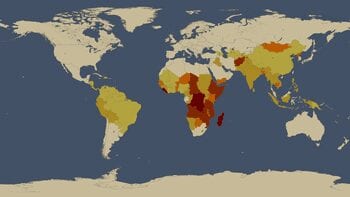
The analysis of large volumes of data collected from fields, warehouses, trucks – and even animals’ stomachs – may be key to preventing widespread hunger in the coming decades.
The world’s population is projected to grow to 9 billion by 2050, and the Food and Agriculture Organization of the United Nations believes that food production will have to increase by 70% in the next 35 years to prevent widespread hunger.
But the increasing use of farmland for biofuel production means that there is less land available for food, and about half – or two billion tonnes – of the food that is produced is wasted, according to the Institution of Mechanical Engineers.
Technology and data analysis could help improve the situation.
Sonar cows
For example, innovations in the way data can be collected from cattle have the potential to transform dairy and beef production.
Vital Herd, a Texas-based start-up, has developed a device that can be swallowed by cows. The sensor, or e-Pill, sits in the cow’s rumen and uses sonar technology – originally developed for military purposes – to collect information about the animal, including heart rate, temperature, rumination time, rumen acidity and oestrogen levels. It will be available commercially later this year.
The information stored on each e-Pill will be transmitted wirelessly to receivers as cows pass by, and then through the internet to Vital Herd’s cloud-based herd management software. This will collate and interpret the data about each animal so it can be viewed by farm managers. The software will send out alerts by text message or email if it appears that individual animals have anything seriously wrong with them.
“Forty per cent of dairy cows get ill each year,” explains Brian Walsh, Vital Herd’s chief executive. “The cause can be early lactation, the type of feed they are receiving or one of a very large spectrum of health complications. Early warning or auto-detection can help minimise complications or avoid them altogether.”
The US Department of Agriculture says total economic loss from animal sickness and death is more than $5bn (£3bn) a year, with global losses amounting to 12 times this.
Mr Walsh believes that more productivity benefits will be realised by analysing historical data from a wide range of cattle. “If we can aggregate data from customers in different regions we could do industry benchmarking and studies to link productivity to vital sign data and genetics,” he says.
Cloud farming
Big data analysis can also increase crop yields by helping famers make better decisions about when to plant, manage and harvest their crops.
The Latest on: Feed the world
[google_news title=”” keyword=”Feed the world” num_posts=”10″ blurb_length=”0″ show_thumb=”left”]
via Google News
The Latest on: Feed the world
- PBFA: “The Plant-Based Foods Industry Represents an Opportunity to Re-Envision How We Feed the World”on April 26, 2024 at 3:44 am
The Plant Based Foods Association (PBFA) is a pivotal organization in the plant-based food industry, founded with the mission to promote the expansion and ...
- Meet the American who invented the gas-powered tractor, entrepreneur John Froelich, helped feed the worldon April 26, 2024 at 1:01 am
John Froelich, the oldest son of German immigrants, was born in Iowa in 1849. The grain mill operator tinkered away on a gasoline traction, the tractor, that changed global agriculture.
- John Froelich helped feed the world — here's how an Iowa plowman fueled an agricultural revolutionon April 25, 2024 at 6:34 pm
The son of German immigrants, John Froelich paired a gas engine with gears and wheels to create the first tractor; it fed a growing nation and created an all-American image.
- Congress must oppose Farmers Feed the World Act to save key hunger programon April 25, 2024 at 12:11 pm
As a volunteer of Catholic Relief Services, St. Joseph's Church, Babylon Chapter, we have been urging Congress to prioritize the Farm Bill and to oppose the American Farmers Feed the Worl... An online ...
- Children of Hineahuone feed the worldon April 9, 2024 at 6:59 am
A Māori agriculture scientist says the food systems need to be seen in terms of tino rangatiratanga and mana motuhake. Jessica Hutchings has organised this week’s He Whenua Rongo symposium at Te ...
- Can Africa one day help feed the world’s growing population?on April 2, 2024 at 4:59 pm
It is a massive gamble given that Africa had to import $43bn of food in 2019, according to World Bank estimates. That figure is set to rise to $110bn by 2025, it predicts. Unmanned aerial vehicles ...
- Video: Give Someone a Fish, You Feed Them - Unlock the Fish Genome, You Feed the World | Morningstaron March 7, 2024 at 6:45 am
Morningstar brands and products Company Get 7 Days Free ...
- Scientists say this food source could feed the world after devastating nuclear waron February 3, 2024 at 9:13 am
With World War 3 potentially on the horizon ... as seaweed would mostly be directed to animal feed and biofuel production. Harrison added that the project could also be used to serve as ...
- Empowering female farmers to feed the worldon January 22, 2024 at 6:31 pm
Abolishing gender-specific barriers in farming, the FAO reports, would not only empower women to achieve their highest economic potential, it could help feed a hungry world. According to the FAO ...
- How Are We Going To Feed The World? A New Mindset For Food Securityon August 14, 2023 at 1:28 am
I cover soft power and strategies of influence and persuasion. There are times when the world's nations pull together suddenly to set new goals and create institutions that advance shared peace ...
via Bing News










